Japan's Ryokan -- Sleep In Tradition(from May, 2005 issue of United Airlines Hemispheres) |
by Harris Salat http://www.harrissalat.com photo: by Harumi Okochi |
|
The venerable ryokan imparts the Japanese tradition of hospitality, but it is not the hospitality of a hotel; it is that of a Japanese home. |
||
|
I realized I was in for a different kind of hotel experience the moment I parted the entrance curtains. Four staffers wearing loose fitting indigo-colored outfits that looked like karate uniforms rushed to meet me. "Otsukaresama" -- welcome! -- they said, as they smiled and bowed. One of the clerks went further, and took a respectful bow so low it brought her to the ground like she was doing a yoga pose. I couldn't remember the last time the doorman of a four-star hotel got on hands and knees to welcome me. I was entering new territory here. |
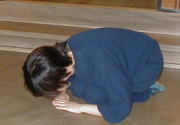 "Irasshaimase" |
|
|
The place was a venerable ryokan, or traditional Japanese inn, called Yoyokaku, located in the pleasant seaside town of Karatsu. The dramatic greeting, I would soon learn, was a hint of hospitality to come. Ryokans like Yoyokaku are dotted across Japan. Much more than hotels with tip-top service, these inns are cultural time capsules, a special place Japanese go for one or two nights to connect with their traditions -- and take a relaxing break from modern life. Lucky for the rest of us, we can do the same. It's as simple as taking a bath, eating dinner and going to sleep. Or as complex. |
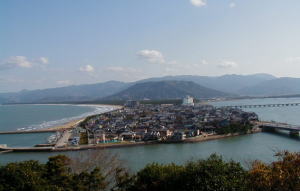 View from Karatsu Castle |
|
|
These elegant inns got their start in the seventeenth century because of a problem that bedeviled the shogun, or emperor, of Japan. He had 250 semi-autonomous domains spread across mountains and forests, each run by a daimyo, or warlord -- and he had to keep them in line. What was a shogun to do? Impose a ruthless solution, naturally. The daimyos' families were forced to live in the capital -- as hostages -- and the daimyos were ordered to visit the shogun, and the wife and kids, every other year. These lordly road trips, with long retinues of samurai and retainers, were monstrously expensive. So they left the daimyos permanently strapped -- with no money to pay for, say, rebellions. |
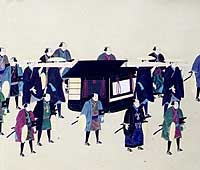 Daimyo is travelling. |
|
|
The daimyos lodged in luxe places on these journeys, and soon merchants and others started patronizing them, too. A singular Japanese tradition of hospitality was born -- but not the hospitality of a hotel, the hospitality of a traditional Japanese home. Yoyokaku was such a home. |
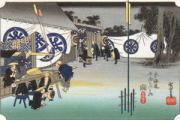 Daimyo's staying house. |
|
|
The okami-san, the proprietress, offered me slippers and I advanced into the ryokan. I quickly noticed two things. First was the smell. Yoyokaku opened in 1896 and has just twenty rooms. It was a Japanese architectural gem, built from sturdy cedar timbers felled from nearby forests. So it was like stepping inside a giant cedar closet -- instantly calming. |
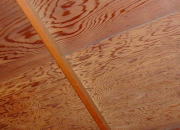 Cedar ceiling |
|
|
The other thing was my fellow guests. They were lolling around in the hallways like they just woke from a nap. If you ever witnessed the electric pace of a Tokyo sidewalk this was a startling contrast. And they had shed their street clothes, wearing instead yukata, traditional blue-and-white cotton robes that reached to their ankles and had wide sleeves. Since the ryokan was "home," why not poke around in your robe? They had entered the time capsule. Now it was my turn. The ryokan experience is about stepping through a series of time-honored rituals -- like wearing the yukata -- that are second nature to Japanese guests. But not to me, the only foreigner here. It was okay, though. The kind owners, who happened to speak English, gave me the ryokan equivalent of a golf handicap and helped me understand. |
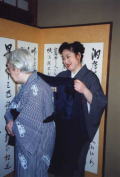 Chambermaid helping a guest to change to Yukata |
|
| The ryokan experience is also about indulgent care. Think of the okami-san as Mom and you as the spoiled Child. My fellow guests arrived from as far away as Tokyo, 700 miles to the north, not to explore the area, but to stay put for a taste of this tender, loving service. | 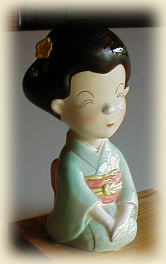 Okami-san |
|
|
The okami-san introduced me to my classic Japanese room, inspired by the way ancient Buddhist temples were built, big multipurpose halls with no interior walls. So it was a Swiss Army knife of a room, my living, dining and bedroom all rolled up into one. And it was a surprisingly empty one. Furniture and bedding were traded in and out as needed. I soon realized my room was, however, chock-full of traditional accents, also rooted in the temples. There was the tokonoma, the place of honor, an alcove where a scroll painting hung and fresh-cut camellias were arranged. Shoji, sliding translucent paper screens, covered the windows. And the floors were tatami, interlocking mats of woven reeds packed with straw. My room was also big enough to sleep up to five -- families all sleep together here, just like in the old days. |
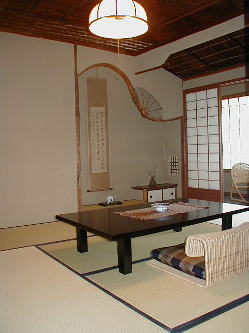 Guest room |
|
|
The okami-san politely served me o-cha, green tea, and sweet rice crackers on a low table. Life takes place at ground level in a traditional Japanese room, so I sat cross-legged on the tatami. But if you haven't done deep knee bends since junior high, you can sit on a za-isu, which is like a chair without legs. |
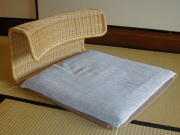 za-isu |
|
|
I was now ready for the Mt. Olympus -- make that Mt. Fuji -- of rituals, the Japanese bath. The bathing tradition started early in Japan, in 552 AD when Buddhism arrived to the country. Baths were originally attached to temples and quickly became a vital part of everyday life. As the Buddha himself explained, "bathing rids seven illnesses and brings seven lucks." But it's bathing to soak, not to wash, which you do beforehand. Japanese call this soaking tsukeru, literally, "to be pickled." The men's bath here was an o-furo, a serene indoor pool built of black granite that looked out to a formal Japanese garden. A tap at one end fed a stream of fresh water. It was big enough to fit five, and four guests were soaking when I arrived. They were chatting - and also bathing together completely naked. People in Japan like to do things as a group and bathing is no exception. If you're not Japanese, this can take some getting used to. But it's such a natural part of life here, no one else cares. What my fellow bathers did care about, I could see from their worried faces, was if I got the wash-then-soak routine. So I soaped and scrubbed at a nearby wash stall like a rancher after a long cattle drive before I slowly eased myself into the o-furo. Baths in Japan are ferociously hot; this one was 108 degrees Fahrenheit. I let out a deep exhale and stared at the 300-year-old sculpted pines in the garden. I had entered cornichon country. |
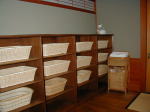 Leave your clothes in the basket  O-furo  O-furo stool and bowl |
|
|
It was now early evening and I was out of the bath and ambling around in my yukata like the guests I saw earlier. It was time to eat. Dinner is the centerpiece of the ryokan experience and Yoyokaku was justly proud of theirs. It was an elaborate affair -- and the ultimate indulgence. I was served in my room, which was now transformed into a fine private restaurant. This was anything but room service. There was no menu -- and no sushi. The meal was a ryokan staple called
kaiseki, a traditional dinner with a hallowed 500-year history that traces
back, like the bath, to Buddhist temples. It was, well, sugoi -- wow! Part
meal, part theater, it unfolded as a series of carefully prepared small
dishes served one at a time by the chambermaid who was now my personal
butler. |
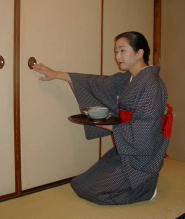 Serving dinner |
|
|
The Japanese have a saying that food should be as pleasing to the eye as to the taste buds. Yoyokaku's chef delivered the goods. His dishes, presented on hand-thrown pottery, looked like works of art. And his food was a delight, a mix of things I've never tried to things I thought I knew. There were hors d'oeuvres called sake no sakana, "nibbles to have with sake." The sashimi was raw slices of amberjack, grouper, squid and shrimp caught that morning. Other local ingredients arrived, too, but prepared in surprising ways, like yellowtail braised in a caramelized soy sauce. Sugoi. My chambermaid made sure to top off my sake cup throughout the meal. Tomewan, the traditional "final bowl" of miso soup along with steamed rice and pickles signaled the end to this leisurely dinner, nine courses in all. |
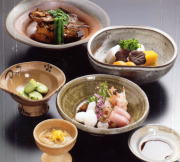 Pottery and food |
|
I was now pickled, stuffed and a little tipsy. It was time to close my eyes. My chambermaid reinvented my room once again and rolled out, on the springy tatami, a futon, or traditional Japanese bed. Make that a bed sandwich. There was the shiki buton, the thick cotton batting underbed and the kake buton, the feathery duvet overbed. I slid into the middle and was instantly out. Sleeping Japanese-style, in my mind, is the greatest cure to insomnia ever
invented. |
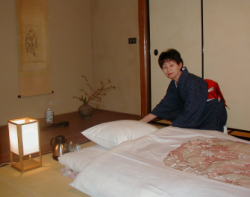 Preparing Futon |
|
|
The next morning I ate the ryokan-style breakfast, which was not bacon and eggs but a traditional Japanese morning meal: rice, pickles, broiled fish and steamed egg custard. I washed it down with tea instead of coffee. I was soon packed and on my way. |
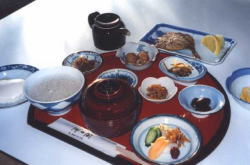 Japanese breakfast |
|
|
The staff rushed to the door and smiled and bowed as they thanked me and said goodbye. And yes, that clerk did another one of her yoga bows as I left. I was back in the modern world after a taste of Japanese culture, relaxed and reinvigorated. The time capsule had worked its magic. |
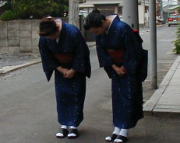 "Arigatougozaimasita" |
|
||||||||
Harris Salat dreams of building an o-furo in his New York City apartment.  Thank you, Harris-san. When your o-furo is completed, please let me know. I will send you a sweet rubber duckie. Information
Dear friends, if you live in or near New York City, please go and see. Thank you. |
||||||||
|
||||||||

